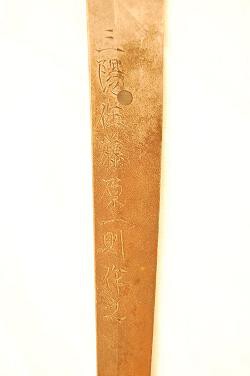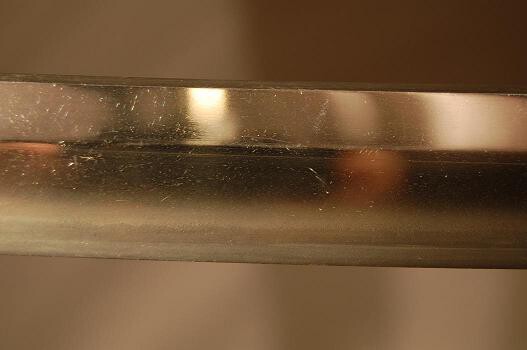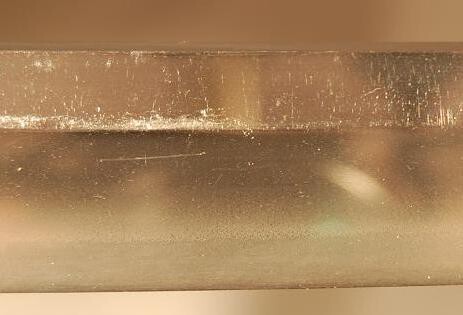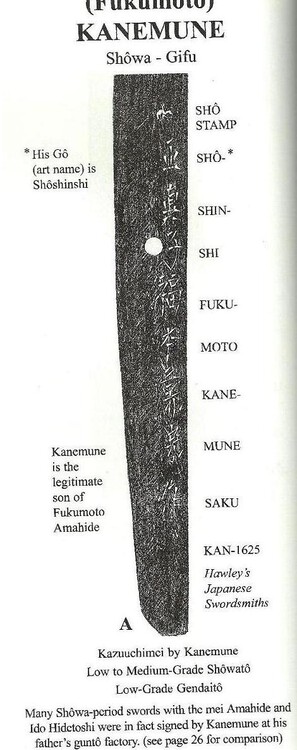
mdiddy
Dealers-
Posts
642 -
Joined
-
Last visited
-
Days Won
1
Content Type
Profiles
Forums
Events
Store
Downloads
Gallery
Everything posted by mdiddy
-
I have held and owned several Nagamitsu, some of which had been polished, and have not noticed a difference in quality based on length of signature. From an artistic standpoint, they were all of seemingly good quality with consistent hamon (usually some gunome variant) and hataraki in both ji and hamon. From an iai practitioner's standpoint, I would be curious if they differ in quality as I have noticed differences in the shape and curvature, with many being what I would call 'stout' (shorter and thicker). I have always heard they performed well in cutting and I think the 'world-record' tameshigiri was performed with a Nagamitsu. One difference I have noticed though is that earlier Nagamitsu seem to be of lower quality as compared to later Nagamitsu. Most Nagamitsu I have held were not dated, but I implied some crude dating based on the mounts, earlier being mounted in Type 98 mounts and later in Type 3 mounts (most Nagamitsu are seen in Type 3 mounts). There are similarities, but the earlier Nagamitsu seem more crude, lack hataraki, and had more basic hamon. In my opinion, every Nagamitsu I have held was of higher quality than Seki Showa-to, but no Nagamitsu was of higher quality than examples I have held by Seki Kanehide or Seki Kanenori. The examples I have held by those two smiths all displayed more consistent hamon and more varied hataraki. Keep in mind though that I am just a lay collector and not an Iai practitioner or on a Shinsa panel. Finally, I agree with Chris that Nagamitsu was probably not a lone smith cranking these out and had some kind of operation. If he had an operation then many could be dai mei which could explain the varying signatures but consistent quality. My experience is based on handling maybe 50 Nagamitsu which could be a limited set so please take that into consideration.
-
I am pretty sure that is Sgt. Coldy Bimore and he is holding the Honjo Masamune! Richard Fuller notes in Japanese Military and Civil Swords and Dirks that this sergeant did not bring back any swords himself. I would suggest reaching out to Mr. Fuller and seeing if he would know this sergeant's name as well as his story. I for one would be interested in hearing it.
-
FWIW - I would value an amateur polish (or no polish) over that of a professional polish where the intent was to harm the sword for whatever reason (repurchase by the togishi, etc). I realize this subject is not often discussed and the situation is the exception, not the norm, but it does occur given the value of these items. I think my point here is that I value trusting the togishi first over any advertisements, accolades of service, or 'professional'-ism. Getting to know a togishi at a personal level first before imparting to them, or middle-men, $4k worth of work and a valued item seems prudent in my mind. Just my $.02 (1.5 Yen) EDIT - just read Clive's post and I think he sums it up best.
-
My only feedback for Louis is that maybe its time to pave the driveway: . :lol: Not to stray too far OT but is that a 40 series cruiser? What year?
-
Bojan, Clive Sinclaire has a good write-up (w/ oshigata) on Inshu Kanesaki here: http://www.to-ken.com/swordregister/No90fujiwara.htm. Also, here are a few more examples I found online: 1. http://www.sho-shin.com/inshu%20Kanesaki.html 2. http://www.choshuya.co.jp/1/0706/thanks_sword.htm (scroll down to the bottom) 3. http://www.finesword.co.jp/sale/touken/ ... nesaki.htm 4. http://www.e-sword.jp/sale/2009/0910_1093syousai.htm 5. http://www.e-sword.jp/sale/2009/0910_1094syousai.htm Its hard to judge from just a few pictures, but I can see the sunagashi brushing through the gunome peaks in your pictures. Fujishiro states "there are various mei of Kanesaki besides [iNABA KUNI FUJIWARA KANESAKI], most of them are the Kanesaki of around Kanbun." Best, Matt
-
Bojan, Here is your mei compared to oshigata from Shinto Shu and Nihonto Zuikan. Fujishiro notes that there are various mei of Kanesaki, most from around Kanbun. Would like to see pics of the sword. Best, Matt
-
Rich, Thanks for the exercise. I enjoyed your pictures very much. Do you have any guidance on which generation Motoshige this is? Matt
-
Chikuzen Nobukuni school were known for making fukuro yari for Kuroda clan in Fukuoka.
-
Bruno - I agree. I think Type 3 is correct and we were incorrect with Type 98. Good catch.
-
I think we have seen this one before: viewtopic.php?f=50&t=9580&hilit=yasukuni.
-
I thought about that and my hypothesis is that it has less to do with concentration of quality blades in the Olive green type 98 mounts by smith and more to do with offering choice from higher end commercial websites.
-
I have owned a katana by Sanyo Kazunori that was in these olive green mounts. It was made in 1944, not star-stamped, but showed hada and had an active hamon with ko-ashi and nie hotsure. It may not have been made of pure tamahagane, but it was certainly a step above most low-grade oil-quenched showa-to that are mostly seen in these mounts. Attached are a couple of pics below. Also, here is a star-stamped Kanehide from Danny Massey's site that is mounted in these olive green mounts: http://www.nihontocraft.com/Kanehide.html Here is another: http://www.samuraisword.com/nihonto_c/S ... /index.htm
-
tampa show
mdiddy replied to lbkmd43's topic in Sword Shows, Events, Community News and Legislation Issues
Curran, You are right. How could I be so daft. Fozzie is of the Muppet school which I would regard as waka, waka, wakamono... Matt -
tampa show
mdiddy replied to lbkmd43's topic in Sword Shows, Events, Community News and Legislation Issues
I attended Pete’s lecture on Nobuie and found it highly insightful. He started the lecture by spending a good deal of time setting the stage for the arrival of Nobuie by discussing the impact of Sen Rikyu and the tea ceremony on Japanese culture in the 1500s, focusing on the importance of simplicity and subdued design in the transition from a Chinese-based aesthetic to a purely Japanese aesthetic. If I remember right, he cited Nobuie’s mastery of this theme as what made them such a departure point from previous work and a radical brand of tsuba. He also incorporated the influence of Christianity on some designs and the possible influence of Oda Nobunaga on the usage of ‘Nobu’ in their naming convention. He showed and discussed several examples of Nobuie tsuba on his slides, noting key facets like the usage of Ji-mon- the fine surface designs in their background, their method of applying carving without it necessarily being kebori, and how one can rely on the length of the first radical in ‘Nobu’ to differentiate 1st from 2nd generation. He pointed out commonalities in shape, design, theme, etc with their work. He also highlighted rare examples when they departed from their normal style, such as a tsuba that relied on heavy sukashi for depiction of a shrine gate. He also specified his personal favorites including an amida yasuri Nobuie. There were 4 genuine examples for hands-on study as well as one Kaneie example for contrast. Also, there were several texts with pictures on the subject available for reference. I thought his presentation was comprehensive and thorough. It certainly added depth to my understanding of these works. He also had a slide devoted to Fozzie from Sesame Street. -
Malcolm, I found this link from the Kashima sisters' site helpful: http://www.ksky.ne.jp./~sumie99/tyingcord.html. Matt
-
For our kindness, can we see the omote and blade perhaps? :D
-
Showa Kanoe Tatsu Haru (Spring 1940).
-
Peter, I would suggest it is lawful to import swords into the U.S. based on the Customs and Border Protection's list of Prohibited and Restricted items here: http://www.cbp.gov/xp/cgov/travel/vacat ... ricted.xml. Some nihonto could fall into the category 'Cultural Artifacts and Cultural Property', however I think those items are already controlled for by the Japanese government with Juyo Bunkazai and higher designations (informative read: http://www.yamabushiantiques.com/BM%20C ... NKAZAI.pdf). Should you try and ship a lost Kokuho into the U.S. you may have a problem, else I take from the CBP list that sword importation is lawful. Matt
-
Grey - I handedly agree. USPS is greatly preferred and obtaining adequate insurance and registering a sword is always an option if particularly paranoid about losing it. I think the only thing FedEx can do is deliver internationally in a shorter amount of time.
-
Peter, How did you list the sword on your customs declaration? I'm wondering - and am curious to know - if it was rejected due to the declaration or if they scanned/opened the package and then sent it back. I have shipped swords from the USA using FedEx and the first time I tried them they would not accept the package because of the description of the contents (i.e. "Japanese Sword"). When I changed the description to "Japanese Nihonto" and told them it was antique art it was accepted and made it to the destination. Matt
-
T., Below is a scan of oshigata from John Scott Slough's Modern Japanese Swordsmiths. According to Slough, Kanemune was working in a gunto factory so you could expect chippy meis and slight variations depending on which smith was signing blades that day. Here is a link to Stein's site with more oshigata: http://home.earthlink.net/~ttstein/index.htm. Matt
-
what does it mean if your Showa smith is not listed?
mdiddy replied to a topic in General Nihonto Related Discussion
Mark, I don't think the weird black line is hotsure. I would expect hotsure to occur along the habuchi not necessarily in the middle of the ji. I think the "something" kanji may be "kin" making the mei "Mitsu Masa Kin Saku". Just my $.02. Hope it helps. Matt -
Looks like a fukuro (socketed) jumonji yari. Maybe that is one reason it is shorter.






